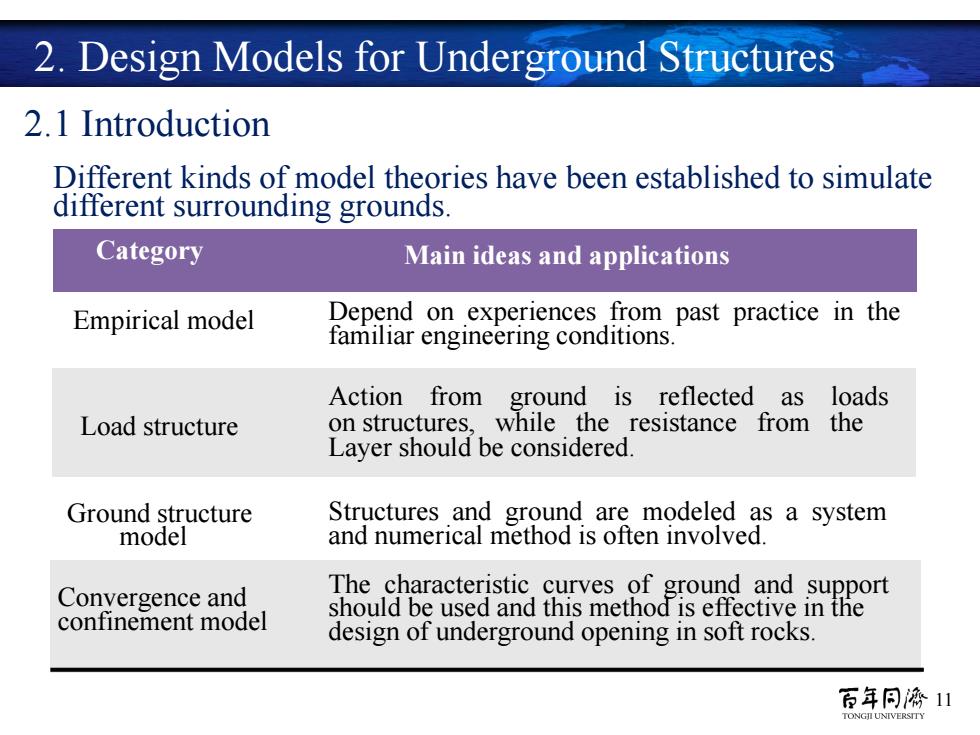
1.Introduction 1.3 Design Principle Principle 3 Instrumentation of pilot excavations and main tunnel for displacements,loads and stresses Principle 3.1 Evaluate the stand-up time Principle 3.2 Select the most appropriate excavation method,support type and installation time Principle 3.3 Design the final tunnel support Monitoring of the tunnel behaviour Evaluate safety of the final structure 百年同濟7
7 Principle 3 Instrumentation of pilot excavations and main tunnel for displacements, loads and stresses Principle 3.1 Evaluate the stand-up time Principle 3.2 Select the most appropriate excavation method, support type and installation time Principle 3.3 Design the final tunnel support Monitoring of the tunnel behaviour Evaluate safety of the final structure 1. Introduction 1.3 Design Principle

1.Introduction 1.3 Design Principle Geology Uncertainty Concrete samples ■Every20to50m3 Test about 0.1 percent -See 100 percent out of the truck -Tunnels (samples 100 m) -About 0.0005 percent 百年同海8
8 Geology Uncertainty Concrete samples Every 20 to 50 m3 Test about 0.1 percent See 100 percent out of the truck Tunnels (samples @ 100 m) About 0.0005 percent 1. Introduction 1.3 Design Principle

1.Introduction 1.3 Design Principle Stress-Strain Analysis Closed-Form Solutions oSimple Geometry Homogeneous and Isotropic Media Linear Elastic Behaviour 」Numerical Methods Boundary Element oFinite Element ODiscrete Element 百年同海9
9 Stress-Strain Analysis Closed-Form Solutions Simple Geometry Homogeneous and Isotropic Media Linear Elastic Behaviour Numerical Methods Boundary Element Finite Element Discrete Element 1. Introduction 1.3 Design Principle

1.Introduction 1.4 Design Documents Geo-mechanical model Structural model of the tunnel Assumptions,completeness and type of calculations and simulations Monitoring threshold values Design Reviewer 百年同海10 TONGILUNIVERSITY
10 1.4 Design Documents Geo- mechanical model Structural model of the tunnel Assumptions, completeness and type of calculations and simulations Monitoring threshold values Design Reviewer 1. Introduction

2.Design Models for Underground Structures 2.1 Introduction Different kinds of model theories have been established to simulate different surrounding grounds. Category Main ideas and applications Empirical model Depend on experiences from past practice in the familiar engineering conditions. Action from ground is reflected as loads Load structure on structures,while the resistance from the Layer should be considered. Ground structure Structures and ground are modeled as a system model and numerical method is often involved. Convergence and The characteristic curves of ground and support confinement model should be used and this method is effective in the design of underground opening in soft rocks 百年同濟11 TONGIUNIVERSΠTY
11 2.1 Introduction Different kinds of model theories have been established to simulate different surrounding grounds. Category Empirical model Load structure Ground structure model Convergence and confinement model Main ideas and applications Depend on experiences from past practice in the familiar engineering conditions. Action from ground is reflected as loads on structures, while the resistance from the Layer should be considered. Structures and ground are modeled as a system and numerical method is often involved. The characteristic curves of ground and support should be used and this method is effective in the design of underground opening in soft rocks. 2. Design Models for Underground Structures